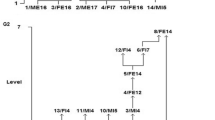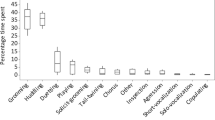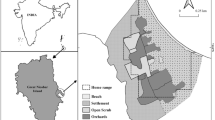Abstract
This paper assesses non-damaging social behaviors as tactics of interindividual competition by a descriptive analysis of dominance, copulation, grooming and play in a captive group of black howler monkeys (Alouatta caraya). The social behavior of this species has not previously been documented in the literature, and it is reported that rank is negatively related to age for adult females, similar to other species ofAlouatta. The significance of non-damaging social behavior to howler monkeys may relate to their folivorous habits and consequently high metabolic costs which increase chances for “aggressive neglect.” With respect to the form of motor patterns, low probabilities of escalation from less aggressive to more aggressive behavior (e.g., from grooming to pairwise supplantation) are associated with “ritualization” of signals, and, apparently, with greater reliability of these signals. It is suggested that non-damaging social behaviors may be costly to reproduction through the depletion of limited time resources, may function generally in the resolution of interindividual conflicts of interest and may be particularly important to the behavioral repertoires of social subordinates.
Similar content being viewed by others
References
Altmann, J., 1974. Observational study of behaviour: sampling methods.Behaviour, 49: 227–267.
————, 1980.Baboon Mothers and Infants. Harvard Univ. Press, Cambridge, Massachusetts.
Carpenter, C. R., 1934. A field study of the behavior and social relations of howling monkeys.Comp. Psychol. Monog., 10: 1–168.
Cheney, D., 1980. The play partners of immature baboons.Anim. Behav., 26: 389–408.
Clutton-Brock, T. H. &P. H. Harvey, 1977. Species differences in feeding and ranging behaviour in primates. In:Primate Ecology,T. H. Clutton-Brock (ed.), Academic Press, New York, pp. 557–584.
Cox, C. R., 1981. Agonistic encounters among male elephant seals: frequency, context and the role of female preference.Amer. Zool., 21: 197–209.
———— &B. J. LeBoeuf, 1977. Female incitation of male competition: a mechanism in sexual selection.Amer. Naturalist, 111: 317–335.
Emlen, J. M., 1973.Ecology: An Evolutionary Approach. Addison-Wesley, Reading, Massachusetts.
Eisenberg, J. H., N. A. Muckenhirn &R. Rudran, 1972. The relation between ecology and social structure in primates.Science, 178: 863–874.
Fagen, R. M., 1980. When doves conspire: evolution of non-damaging fighting tactics in a non-random-encounter animal conflict model.Amer. Naturalist, 115: 858–869.
Glander, K. E., 1975. Habitat and resource utilization: an ecological view of social organization in mantled howling monkeys. Ph.D. Dissertation, Univ. of Chicago, Illinois.
Jeanne, R. L., 1972. Social biology of the Neotropical waspMischocyttarus drewseni.Bull. Mus. Comp. Zool., 144: 63–150.
Jolly, A., 1972.The Evolution of Primate Behavior. Macmillan, New York.
Jones, C. B., 1978. Aspects of reproduction in the mantled howler monkey (Alouatta palliata Gray). Ph.D. Thesis, Cornell Univ., Ithaca, New York.
————, 1979. Grooming in the mantled howler monkey,Alouatta palliata Gray. Primates, 20: 289–292.
————, 1980. The functions of status in the mantled howler monkey,Alouatta palliata Gray: intraspecific competition for group membership in a folivorous Neotropical primate.Primates, 21: 389–405.
————, 1981. The evolution and socioecology of dominance in primate groups: a theoretical formulation, classification and assessment.Primates, 22: 70–83.
Maynard Smith, J. &G. R. Price, 1973. The logic of animal conflict.Nature, 246: 15–18.
McCleery, R. G., 1978. Optimal behaviour sequences and decision making. In:Behavioural Ecology,J. R. Krebs &N. B. Davies (eds.), Sinauer, Sunderland, Massachusetts, pp. 377–410.
Milton K., 1979. Factors influencing leaf choice by howler monkeys: a test of some hypotheses of food selection by generalist herbivores,Amer. Naturalist, 114: 362–378.
Moynihan, M., 1969. Comparative aspects of communication in New World primates. In:Primate Ethology,D. Morris (ed.), Anchor, New York, pp. 306–342.
----, 1970. Some behavior patterns of platyrrhine monkeys II.Saguinus geoffroyi and some other tamarins.Smithsonian Contrib. Zool., 28: iii-77.
————, 1976.The New World Primates. Princeton Univ. Press, Princeton, New Jersey.
Oates, J. F., 1977. The guereza and its food. In:Primate Ecology,T. H. Clutton-Brock (ed.), Academic Press, New York, pp. 276–323.
Parker, G., 1974. Assessment strategy and the evolution of fighting behavior.J. Theor. Biol., 47: 223–243.
Popp, J. L. &I. DeVore, 1979. Aggressive competition and social dominance theory: synopsis. In:The Great Apes,D. A. Hamburg &E. R. McCown (eds.), Benjamin-Cummings, Reading, Massachusetts, pp. 317–340.
Rose, R. M., J. W. Holaday &I. S. Bernstein, 1971. Plasma testosterone, dominance rank and aggressive behaviour in male rhesus monkeys.Nature, 231: 366–368.
Rudran, R., 1979. The demography and social mobility of a red howler (Alouatta seniculus) population in Venezuela. In:Vertebrate Ecology in the Neotropics,J. F. Eisenberg (ed.), Smithsonian Press, Washington, D.C., pp. 107–126.
Trivers, R. L., 1972. Parental investment and sexual selection. In:Sexual Selection and the Descent of Man,B. Campbell (ed.), pp. 136–179.
West-Eberhard, M. J., 1979. Sexual selection, social competition and evolution.Proc. Amer. Phil. Soc., 123: 222–234.
Wilson, E. O., 1971.The Insect Societies. Harvard, Cambridge, Massachusetts.
————, 1975.Sociobiology. Harvard, Cambridge, Massachusetts.
Zahavi, A., 1974. Communal nesting by the Arabian babbler.Ibis, 116: 84–87.
————, 1979. Ritualization and the evolution of movement signals.Behaviour, 72: 77–80.
Author information
Authors and Affiliations
About this article
Cite this article
Jones, C.B. Social organization of captive black howler monkeys (Alouatta caraya): “Social competition” and the use of non-damaging behavior. Primates 24, 25–39 (1983). https://doi.org/10.1007/BF02381451
Received:
Accepted:
Issue Date:
DOI: https://doi.org/10.1007/BF02381451




